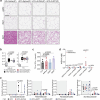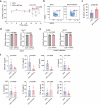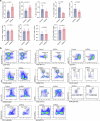Human gut microbial aromatic amino acid and related metabolites prevent obesity through intestinal immune control
- PMID: 40087408
- PMCID: PMC12021661
- DOI: 10.1038/s42255-025-01246-5
Human gut microbial aromatic amino acid and related metabolites prevent obesity through intestinal immune control
Abstract
Obesity affects millions of people in the world. The gut microbiome influences body fat accumulation, but the mechanisms remain to be investigated. Here, we show an association between microbial aromatic amino acid metabolites in serum and body fat accumulation in a large Chinese longitudinal cohort. We next identify that 4-hydroxyphenylacetic acid (4HPAA) and its analogues effectively protect male mice from high-fat-diet-induced obesity. These metabolites act on intestinal mucosa to regulate the immune response and control lipid uptake, which protects against obesity. We further demonstrate that T cells and B cells are not vital for 4HPAA-mediated obesity prevention, and innate lymphoid cells have antagonistic roles. Together, these findings reveal specific microbial metabolites as pivotal molecules to prohibit obesity through immune control, establishing mechanisms of host modulation by gut microbial metabolites.
© 2025. The Author(s).
Conflict of interest statement
Competing interests: A patent using related molecules to prevent and treat obesity has been filed by Westlake University, with J.Z., L.AT., L.H., Diyin Li and Z.J. listed as inventors. The remaining authors declare no competing interests.
Figures


















References
-
- Twig, G. et al. Body-mass index in 2.3 Million adolescents and cardiovascular death in adulthood. N. Engl. J. Med.374, 2430–2440 (2016). - PubMed
-
- Bjerregaard, L. G. et al. Change in overweight from childhood to early adulthood and risk of type 2 diabetes. N. Engl. J. Med.378, 1302–1312 (2018). - PubMed
-
- Wearing, S. C., Hennig, E. M., Byrne, N. M., Steele, J. R. & Hills, A. P. Musculoskeletal disorders associated with obesity: a biomechanical perspective. Obes. Rev.7, 239–250 (2006). - PubMed
-
- Avgerinos, K. I., Spyrou, N., Mantzoros, C. S. & Dalamaga, M. Obesity and cancer risk: emerging biological mechanisms and perspectives. Metabolism92, 121–135 (2019). - PubMed
MeSH terms
Substances
Grants and funding
- 2023YFC2308403/Ministry of Science and Technology of the People's Republic of China (Chinese Ministry of Science and Technology)
- 2024SSYS0032/Science and Technology Department of Zhejiang Province
- 32430002/National Natural Science Foundation of China (National Science Foundation of China)
- 82471502/National Natural Science Foundation of China (National Science Foundation of China)
- 82073546/National Natural Science Foundation of China (National Science Foundation of China)
- 82073529/National Natural Science Foundation of China (National Science Foundation of China)
- LRG25C010001/Natural Science Foundation of Zhejiang Province (Zhejiang Provincial Natural Science Foundation)
- LZ23H260001/Natural Science Foundation of Zhejiang Province (Zhejiang Provincial Natural Science Foundation)
LinkOut - more resources
Full Text Sources
Medical

